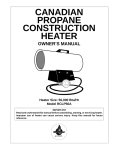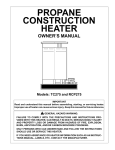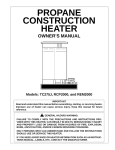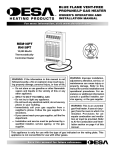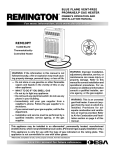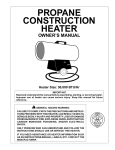Download Dayton 4E769B Operating instructions
Transcript
4E769B Operating Instructions & Parts Manual Please read and save these instructions. Read carefully before attempting to assemble, install, operate or maintain the product described. Protect yourself and others by observing all safety information. Failure to comply with instructions could result in personal injury and/or property damage! Retain instructions for future reference. Dayton Propane Construction Heater ® Description Dayton Model 4E769B heater is a 35,000 BTU/Hr construction heater. This heater uses propane gas for combustion and electricity to run the motor. It is primarily intended for temporary heating of buildings under construction, alteration, or repair. This heater should only be used indoors but never in occupied dwellings. Unpacking 1. Remove all packing items applied to heater for shipment. Keep plastic cover caps (attached to inlet connector and hose/regulator assembly) for storage. 2. Remove all items from carton. 3. Check all items for shipping damage. If heater is damaged, promptly inform dealer where you bought heater. Figure 1 – Model 4E769B GENERAL HAZARD WARNING Failure to comply with the precautions and instructions provided with this heater can result in death, serious bodily injury, and property loss or damage from hazards of fire, explosion, burn, asphyxiation, carbon monoxide poisoning, and/ or electrical shock. Only persons who can understand and follow instructions should use or service this heater. If you need assistance or heater information such as an instructions manual, labels, etc. contact the manufacturer. Fire, burn, inhalation, and explosion hazard. Keep solid combustibles such as building materials, paper or cardboard, a safe distance away from the heater as recommended by the instructions. Never use the heater in spaces which do or may contain volatile or airborne combustibles, or products such as gasoline, solvents, paint thinner, dust particles, or unknown chemicals. Not for home or recreational vehicle use. Heater is designed and approved for use as a construction heater under ANSI Z83.7. The primary purpose of construction heaters is to provide temporary heating of buildings under construction, alteration or repair, and to provide temporary emergency heat. Properly used, the heater provides safe economical heating. Products of combustion are vented into the area being heated. We cannot foresee every use which may be made of our heaters. Check with your local fire safety authority if you have questions about heater use. Other standards govern the use of fuel gases and heat producing products for specific uses. Local authorities can advise you about these. Form 5S3439 ® Printed in U.S.A. 03430 1199/511/VCPVP Version B - For Reduction G016.J 4E769B Dayton Operating Instructions and Parts Manual Dayton Propane Construction Heater ® General Safety Information Make certain you read and understand all warnings. Keep these instructions for reference. They are your guide to safe and proper operation of this heater. Safety information appears throughout these instructions. Pay close attention to them. Below are definitions for the safety information listed throughout this manual. Under this heading, installation, operating, and maintenance procedures or practices will be found that, if not carefully followed, WILL result in IMMEDIATE serious personal injury or death. Under this heading, installation, operating, and maintenance procedures or practices will be found that, if not carefully followed, COULD result in severe personal injury or death. Under this heading, installation, operating, and maintenance procedures or practices will be found that, if not carefully followed, MAY result in minor personal injury, product, or property damage. IMPORTANT: Not every possible circumstance that might involve a hazard can be anticipated. The warnings in this manual and on tags or decals affixed to the unit are therefore not all-inclusive. If a procedure, work method, or operating technique not specifically recommended by Dayton is used, you must make sure it is safe for you and others. You should also ensure that equipment will not be damaged or made unsafe by the operating or maintenance method you choose. Carbon monoxide poisoning may lead to death! Some people are more affected by carbon monoxide than others. Early signs of carbon monoxide poisoning resemble the flu, with headaches, dizziness, and/or nausea. If you have these signs, the heater may not be working properly or the areas may not be sufficiently ventilated. Get fresh air at once! Have heater serviced. Propane Gas: Propane gas is odorless. An odor-making agent is added to propane gas. The odor helps you detect a propane gas leak. However, the odor added to propane gas can fade. Propane gas may be present even though no odor exists. • Install and use heater with care. Follow all local ordinances and codes. In the absence of local ordinances and codes, refer to the Standard for Storage and Handling of Liquefied Petroleum Gas ANSI/NFPA 58. This instructs on the safe storage and handling of propane gases.• Use only the hose and factory preset regulator provided with the heater. • Use only propane gas set up for vapor withdrawal. • Provide adequate ventilation. Before using heater, provide at least a sixsquare-foot opening of fresh, outside air. This heater produces carbon monoxide, which is listed by the State of California as a reproductive toxin under Proposition 65. • For indoor use only. Do not use heater outdoors. • Do not use heater in occupied dwellings or in living or sleeping quarters. • Do not use heater in a basement or below ground level. Propane gas is heavier than air. If a leak occurs, propane gas will sink to the lowest 2 possible level and may accumulate to explosive concentrations. • Keep appliance area clear and free from combustible materials, gasoline, paint thinner, and other flammable vapors and liquids. Dust is combustible. Do not use heater in areas with high dust content. • Minimum heater clearances from combustibles: Outlet: 6 Ft. Sides: 2 Ft. Top: 6 Ft. Rear: 2 Ft. • Keep heater at least six feet from propane tank(s). Do not point heater at propane tank(s) within 20 feet. • Keep propane tank(s) below 100° F. • Check heater for damage before each use. Do not use a damaged heater. • Inspect hose before each use of heater. If highly worn or cut, replace before using heater. Use the replacement hose assembly specified in this manual. • Locate heater on stable and level surface if heater is hot or running. • Never block air inlet (rear) or air outlet (front) of heater. • Keep heater away from strong drafts, water spray, rain, or dripping water. • Keep children and animals away from heater. • Never move, handle, or service a hot, operating, or plugged-in heater. Severe burns may result. You must wait 15 minutes after turning heater off. • Never attach duct work to heater. • Do not alter heater. Keep heater in its original state. • Do not use heater if altered. • Turn off propane supply and unplug heater when not in use. • Use only original replacement parts. This heater must use design-specific parts. Do not substitute or use generic parts. Improper replacement parts could cause serious or fatal injuries. Dayton Operating Instructions and Parts Manual Model 4E769B General Safety Information • The electrical connections and grounding of the heater shall follow the National Electric Code, ANSI/ NFPA 70. • Electrical grounding instructions — This appliance is equipped with a three-prong (grounding) plug for your protection against shock hazard and should be plugged directly into a properly grounded three-prong receptacle. • Use only the electrical voltage and frequency specified on model plate. • Use only a three-prong, grounded extension cord. (Continued) Specifications ELECTRICAL SPECIFICATIONS Electrical Input Amperage 120 Volt/60Hertz 2 GENERAL SPECIFICATIONS Output Rating BTU/Hr Fuel 35,000 Only Propane Vapor Fuel Consumption Size L x W x H (Inches) Regulator Outlet Pressure Weight (pounds) .38 Gallons/Hour 1.6 Pounds/Hour 18.5 x 7.7 x 12.8 11" WC 14.5 (Heater) 16 (Shipping) GENERAL SPECIFICATIONS (Cont.) Manifold Pressure Hot Air Output (CFM Approx) 10.8" WC 175 Ignition Manual Piezo Supply Pressure To Regulator Temperature Range For Operating Heater 10 psi Minimum (for) -20° F to 85° F* purposes of input adjustment) Tank Pressure or 200 psi Maximum Motor 2735 RPM (*) When running heater in temperatures above 85° F, high internal temperatures may cause thermal limit device to shut down heater.Minimum ambient operating temperature: -20°F (-28°C). ® 3 Version B - For Reduction G016.J 4E769B Dayton Operating Instructions and Parts Manual Dayton Propane Construction Heater ® Product Identification Shell Hot Air Outlet (Front) Handle Motor Fan Guard Heater Base Piezo Ignitor Button Automatic Control Valve Button Inlet Connector Power Cord Hose /Regulator Assembly Figure 2 – Model 4E769B 4 Dayton Operating Instructions and Parts Manual Model 4E769B Theory of Operation THE IGNITION SYSTEM Propane Supply THE FUEL SYSTEM The piezo ignitor lights the burner. The hose/regulator assembly attaches to the propane gas supply. This provides fuel to the heater. THE AUTOMATIC CONTROL SYSTEM Propane gas and propane tank(s) must to provided by the customer. This system causes the heater to shut down if the flame goes out. THE AIR SYSTEM The motor turns the fan. The fan pushes air into and around the combustion chamber. This air is heated and provides a stream of clean, hot air. Use this heater only with a propane vapor withdrawal supply system. See Chapter 5 of the Standard for Storage and Handling of Liquefied Petroleum Gas, ANSI/NFPA 58. Your local library or fire department will have this booklet. The amount of propane gas ready for use from propane tanks varies. Two factors decide this amount: 1. The amount of propane gas in tank(s) 2. The temperature of tank(s) Combustion Chamber Fan Motor Clean Heated Air Out (Front) Cool Air In (Back) This heater is designed to operate with a minimum 20-pound propane tank. You may need two or more tanks or one larger tank in colder weather. Use a 100-pound tank for longer operation or in very cold weather. Less gas is vaporized at lower temperatures. Your local propane gas dealer will help you select the proper supply system. The minimum surrounding air temperature rating for each heater is -20°F (-29°C). Average Temperature Number of Tanks (oF) at Tank Location (100 pound) Hose/Regulator Assembly Air For Combustion Air For Heating 40° 1 32° 1 20° 1 10° 1 0° 1 -10° 2 -20° 2 Figure 3 - Cross Section Operational View ® 5 Version B - For Reduction G016.J 4E769B Dayton Operating Instructions and Parts Manual Dayton Propane Construction Heater ® Installation Review and understand the warnings in the General Safety Information Section. They are needed to safely operate this heater. Follow all local codes when using this heater. Test all gas piping and connections for leaks after installation or servicing. Never use an open flame to check for a leak. Apply a mixture of liquid soap and water to all joints. Bubbles forming show a leak. Correct all leaks at once. 1. Provide propane supply system (See Propane Supply, page 5). 3. Connect hose to inlet connector. Tighten firmly using a wrench. IMPORTANT: Use extra hose or piping if needed. Install extra hose or piping between hose/regulator assembly and propane tank. You must use the regulator supplied with heater. 4. Open propane supply valve on propane tank(s) slowly. NOTE: If not opened slowly, excessflow check valve on propane tank will stop gas flow. If this happens, close propane supply valve and open again slowly. 5. Check all connections for leaks. 2. Connect POL fitting on hose/regulator assembly to propane tank(s). Turn POL fitting counterclockwise into threads on tank. Tighten firmly using 7/8" wrench. Operation Review and understand the warnings in the General Safety Information section. They are needed to safely operate this heater. Follow all local codes when using this heater. 1. Follow all installation, ventilation, and safety information. 2. Locate heater on stable and level surface. Make sure strong drafts do not blow into front or rear of heater. 3. Plug power cord of heater into a threeprong, grounded extension cord. Extension cord must be at least six feet long. Extension cord must be UL listed. Propane Supply Valve Regulator Inlet Connector Hose Figure 5 - Hose and Inlet Connector POL Fitting Provide at least a one-square-foot opening of fresh, outside air while running heater. If proper fresh, outside air ventilation is not provided, carbon monoxide poisoning can occur. Provide proper fresh, outside air ventilation before running heater. TO START HEATER IMPORTANT: Position regulator so that hose leaving the regulator is in a horizontal position (See Figure 4). This places the regulator vent in the proper position to protect it from the weather. Propane Tank Ventilation Never use an open Flame to check for a leak. Apply a mixture of liquid soap and water to all joints. Bubbles forming show a leak. Correct all leaks at once. 6. Close propane supply valve. Figure 4 - Regulator Position 6 EXTENSION CORD WIRE SIZE REQUIREMENTS Up to 50 feet long, use 18 AWG rated cord. 51 to 100 feet long, use 16 AWG rated cord. 101 to 200 feet long, use 14 AWG rated cord. 4. Plug extension cord into a 120 volt/ 60 hertz, three-hole, grounded outlet. Motor will start. Fan will turn, forcing air out front of heater. 5. Open propane supply valve on propane tank(s) slowly. Dayton Operating Instructions and Parts Manual Model 4E769B Operation (Continued) NOTE: If not opened slowly, excess-flow check valve on propane tank will stop gas flow. If this happens, close propane supply valve and open again slowly. Be sure motor and fan are running before pushing in automatic control valve button. Flames could flash outside heater if motor and fan are not running. 6. Push in and hold automatic control valve button (See Figure 6). Push piezo ignitor button (See Figure 6). You may need to push piezo ignitor button 3-8 times until the burner lights. When burner lights, keep automatic control valve button pushed in. Release button after 30 seconds. NOTE: If heater is unplugged or power outage occurs while heater is running, the thermal limit device will stop fuel flow. A few seconds occur before the thermal limit device activates. During this short time, flames may appear outside the heater. This is normal. The flames will go out when thermal limit device activates. TO STOP HEATER 1. Tightly close propane supply valve on propane tank(s). 2. Wait a few seconds. Heater will burn gas left in supply hose. Do not block the flow of combustion or ventilation air. 3. Unplug heater. TO RESTART HEATER 1. Wait five minutes after stopping heater. Storage Disconnect heater from propane Automatic Control Valve Button Never attempt to service heater while it is connected to propane supply, operating, or hot. Severe burns and electrical shock can occur. Keep heater clear and free from combustible materials, gasoline, and other flammable vapors and liquids. 2. Repeat steps under To Start Heater, page 6. Piezo Ignitor Button Maintenance supply tank(s). 1. Store propane tank(s) in safe manner. See Chapter 5 of Standard for Storage and Handling of Liquefied Petroleum Gases, ANSI/NFPA 58. Follow all local codes. Always store propane tanks outdoors. 2. Place plastic cover caps over brass fittings on inlet connector and hose/ regulator assembly. Figure 6 - Automatic Control Valve Button and Piezo Ignitor Button 3. Store in dry, clean, and safe place. Do not store hose/regulator assembly inside heater combustion chamber. NOTE: If heater fails to ignite, hose may have air in it. If so, keep automatic control valve button pressed and wait 20 seconds. Release automatic control valve button and wait 20 seconds for unburned fuel to exit heater. Repeat step 6. 4. When taking heater out of storage, always check inside of heater. Insects and small animals may place foreign objects in heater. Remove motor and other internal parts if needed to remove foreign objects (See Service Procedures, page 8). 1. Keep heater clean. Clean heater annually or as needed to remove dust and debris. If heater is dirty or dusty, clean heater with a damp cloth. Use household cleaners on difficult spots. 2. Inspect heater before each use. Check connections for leaks. Apply mixture of liquid soap and water to connections. Bubbles forming show a leak. Correct all leaks at once. 3. Inspect hose/regulator assembly before each use. If hose is worn or cut, replace. 4. Have heater inspected yearly by a qualified service agency. 5. Keep inside of heater free from combustible and foreign objects. Remove motor and other internal parts if need to clean inside of heater (See Service Procedures, page 8). 6. Clean fan blades each season or as needed (See Fan, page 8). ® 7 Version B - For Reduction G016.J 4E769B Dayton Operating Instructions and Parts Manual Dayton Propane Construction Heater ® Maintenance (Continued) SERVICE PROCEDURES Never attempt to service heater while it is connected to propane supply, operating, or hot. Severe burns and electrical shock can occur. 4. Remove fan. Be careful not to damage the fan blade pitch. 5. Remove three nuts that attach fan guard to motor using nut-driver. Remove fan guard from motor (See Figure 9). ELECTRICAL SYSTEM The entire electrical system for this heater is contained within the motor. If any part of the electrical system is damaged, you must replace motor. MOTOR REPLACEMENT 1. Remove three screws that attach fan guard to heater shell. Figure 10 - Replacing Motor and Fan Guard into Heater 2. Remove motor and fan guard from heater shell (See Figure 7). FAN Figure 9 - Removing or Attaching Fan Guard from Motor 6. Discard old motor. 1. Remove three screws that attach fan guard to heater shell. 2. Remove motor and fan guard from heater shell (See Figure 11). 7. Attach fan guard to new motor using three nuts. When attaching fan guard to motor, you must position power cord as shown in Figure 9. Tighten nuts firmly. 8. Place fan onto motor shaft of new motor. Figure 7 - Removing Motor and Fan Guard from Heater 3. Use pliers to remove the fan nut from front of motor shaft (See Figure 8). Fan Nut Figure 8 - Removing Fan Nut from Motor Shaft IMPORTANT: When placing fan onto motor shaft, make sure part number stamped on fan is facing motor. Attach fan nut to end of motor shaft. Tighten fan nut firmly. 9. Place motor and fan guard into rear of heater shell. Make sure power cord is properly located (See Figure 10). 10. Insert three screws through heater shell and into fan guard. Tighten screws firmly. 8 Figure 11 - Removing Motor and Fan Guard from Heater Dayton Operating Instructions and Parts Manual Model 4E769B Maintenance (Continued) 3. Use pliers to remove the fan nut from front of motor shaft (See Figure 12). 9. Place motor and fan guard into rear of heater shell. Make sure power cord is properly located (See Figure 13). Rear Head 10.Insert three screws through heater shell and into fan guard. Tighten screws firmly. Fan Nut Ignitor IGNITOR 1. Remove motor and fan guard from heater (See Motor, page 8, steps 1 and 2). Figure 12 - Removing Fan Nut From Motor Shaft 4a. If replacing fan, remove old fan and discard. Go to step 7 below. 4b. If cleaning fan, remove fan. Be careful not to damage the fan blade pitch. 2. Remove black ignitor wire from piezo ignitor. Access ignitor wire through underside of heater base (See Figure 14). Push wire up through bushing in heater shell. Ignitor Mounting Screw Figure 15 - Removing Ignitor Mounting Screw and Ignitor 7. Set gap between ignitor electrode and target plate to .17" (See Figure 16). Piezo Ignitor Ignitor Wire 5. Clean fan using soft cloth moistened with kerosene or solvent. Target Plate Bushing Gap Area 6. Dry fan thoroughly. 7. Place fan onto motor shaft. IMPORTANT: When placing fan onto motor shaft, make sure part number stamped on fan is facing motor. Ignitor Electrode Underside of Heater Base 8. Attach fan nut to end of motor shaft. Tighten fan nut firmly. Figure 14 - Removing Ignitor Wire from Piezo Ignitor 3. Remove ignitor mounting screw from rear head using nut-driver or standard screwdriver (See Figure 15). 4. Remove ignitor from rear head. 5. Install new ignitor. Attach ignitor to rear head with ignitor mounting screw. Figure 13 - Replacing Motor and Fan Guard into Heater 6. Run ignitor wire from new ignitor through bushing in heater shell. Attach ignitor wire to piezo ignitor. Figure 16 - Clearance Between Ignitor Electrode and Target Plate 8. Test for spark. Make sure heater is disconnected from propane supply. Heater could ignite causing severe burns. Push piezo ignitor button and watch for spark between ignitor electrode and target plate. 9. Place motor and fan guard into rear of heater shell (See Motor, page 8, steps 9 and 10). ® 9 Version B - For Reduction G016.J 4E769B 4E769B Dayton Operating Instructions and Parts Manual Dayton Propane Construction Heater ® For Replacement Parts, call 1-800-323-0620 24 hours a day - 365 days a year Please provide following information: -Model number -Serial number (if any) -Part description and number as shown in parts list Address parts correspondence to: Grainger Parts P.O. Box 3074 Northbrook, IL 60065-3074 U.S.A. 1 RUBBER WASHER FAN NUT 2 4 3 FAN MOTOR 7 MOTOR ASSEMBLY 5 6 2 19 16 10 9 8 21 11 26 18 26 17 22 20 12 21 14 24 23 13 25 15 27 Figure 17 - Replacement Parts Illustration 10 Dayton Operating Instructions and Parts Manual 4E769B Model 4E769BParts List Replacement Reference Number Description Part No. Quantity 1 Inner shell (Combustion Chamber) 099568-01 1 2 #10-16 x 3/8" Hex tap screw 3 Outer shell 099599-01AZ 1 4 Handle M51104-01 1 5 Hex tap shoulder screw 099230-01 4 6 #10-16 x 3/4" Hex tap screw *M11084-29 2 7 #12-14 x 1/2" Hex tap screw *M11084-3 3 8 Thermocouple clip 099237-01 1 *M11084-26 7 9 Burner assembly 099727-01 1 10 Electrode ignitor 099539-01 1 11 #8-18 x 3/8" Hex tap screw *M11084-38 1 12 Fan 099537-01 1 13 Motor assembly (Includes rubber washer and fan nut) 099521-01 1 14 Fan guard 099540-01 1 15 Captive washer nut 097384-02 3 16 #4-40 x 1/2" Hex screw *097968-05 2 17 #4-40 Hex nut *NPC-00C 2 18 Thermal switch kit 101732-02 1 19 Universal bushing 097776-01 1 20 Wire clip 099542-01 1 21 Thermocouple 099538-01 1 22 Valve/orifice assembly 099728-01 1 23 Piezo ignitor 102445-01 1 24 Sleeve cap 078978-03 1 25 Base 103892-01 1 26 #4 Lock washer *100397-01 4 27 1/8" Steel rivet *099202-02 1 100163-03 1 ∆ Tradename decal ∆ Tradename decal 100163-04 1 ∆ General information decal 099548-05 1 ∆ Operation decal 099666-01 1 ∆ LP Warning decal 079663-01 1 ∆ Notice decal 099672-01 1 ∆ Hose/regulator assembly LPA3090 1 (*) Standard hardware item, available locally. (∆) Not shown. ® 11 Version B - For Reduction G016.J 4E769B Dayton Operating Instructions and Parts Manual Dayton Propane Construction Heater ® Never attempt to service heater while it is connected to propane supply, operating, or hot. Severe burns and electrical shock can occur. Troubleshooting Chart Symptom Fan does not turn when heater is plugged in Heater will not ignite Possible Cause(s) Corrective Action 1. No electrical power to heater 1. Check voltage to electrical outlet. If voltage is good, check heater power cord for breaks 2. Fan hitting inside of heater shell 2. Adjust motor/fan guard to keep fan from hitting inside of heater shell. Bend fan guard if necessary 3. Fan blades bent 3. Replace fan. See Fan, page 8 4. Defective motor 4. Replace motor. See Motor, page 8 1. User did not follow installation or operation instructions properly 1. Repeat installation and operation instructions. See Installation, page 6 and Operation, page 6 2. No spark at ignitor. To test for spark, follow step 8 under Ignitor, page 9. If you see spark at ignitor, have heater serviced by qualified service person. If no spark seen: A) Loose or disconnected ignitor wire 2. A) Check ignitor wire. Tighten or reattach loose ignitor wire. See Figure 14, page 9 for ignitor wire location B) Wrong spark gap B) Set gap between ignitor electrode and target plate to .17" C) Piezo ignitor loose C) Tighten nut holding piezo ignitor to base of heater D) Bad ignitor electrode D) Replace ignitor electrode. See Ignitor, page 9 12 Dayton Operating Instructions and Parts Manual 4E769B Model 4E769B Troubleshooting Chart (Continued) Symptom Heater shuts down while running Possible Cause(s) Corrective Action 1. High surrounding air temperature causing thermal limit device to shut down heater 1. This can happen when running heater in temperatures above 85°F. Run heater in cooler temperatures 2. Restricted air flow 2. Check heater inlet and outlet. Remove any obstructions 3. Damaged fan 3. Replace fan. See Fan, page 8 Use only in areas free of high dust content. 4. Excessive dust or debris in surrounding area 4. Clean heater. See Maintenance, page 7 Accessories Description Part No. 10' Rubber Hose with Brass Fitting U.L. listed. LPA1020 15' Rubber Hose with Brass Fitting U.L. listed. LPA1030 Propane Gas Regulator U.L. listed. LPA2110 Hose/Regulator Assembly U.L. listed. LPA3090 Fuel Gas Connector Connects regulator to all standard propane tanks. U.L. and A.G.A. listed. Tank Stabilizer LPA4020 LPA5000 ® 13 Version B - For Reduction G016.J 4E769B Dayton Operating Instructions and Parts Manual Dayton Propane Construction Heater Notes ® ____________________________________________________________________________________________________________________ ____________________________________________________________________________________________________________________ ____________________________________________________________________________________________________________________ ____________________________________________________________________________________________________________________ ____________________________________________________________________________________________________________________ ____________________________________________________________________________________________________________________ ____________________________________________________________________________________________________________________ ____________________________________________________________________________________________________________________ ____________________________________________________________________________________________________________________ ____________________________________________________________________________________________________________________ ____________________________________________________________________________________________________________________ ____________________________________________________________________________________________________________________ ____________________________________________________________________________________________________________________ ____________________________________________________________________________________________________________________ ____________________________________________________________________________________________________________________ ____________________________________________________________________________________________________________________ ____________________________________________________________________________________________________________________ ____________________________________________________________________________________________________________________ ____________________________________________________________________________________________________________________ ____________________________________________________________________________________________________________________ ____________________________________________________________________________________________________________________ ____________________________________________________________________________________________________________________ ____________________________________________________________________________________________________________________ ____________________________________________________________________________________________________________________ ____________________________________________________________________________________________________________________ ____________________________________________________________________________________________________________________ ____________________________________________________________________________________________________________________ ____________________________________________________________________________________________________________________ ____________________________________________________________________________________________________________________ ____________________________________________________________________________________________________________________ 14 Dayton Operating Instructions and Parts Manual 4E769B Model Notes 4E769B ____________________________________________________________________________________________________________________ ____________________________________________________________________________________________________________________ ____________________________________________________________________________________________________________________ ____________________________________________________________________________________________________________________ ____________________________________________________________________________________________________________________ ____________________________________________________________________________________________________________________ ____________________________________________________________________________________________________________________ ____________________________________________________________________________________________________________________ ____________________________________________________________________________________________________________________ ____________________________________________________________________________________________________________________ ____________________________________________________________________________________________________________________ ____________________________________________________________________________________________________________________ ____________________________________________________________________________________________________________________ ____________________________________________________________________________________________________________________ ____________________________________________________________________________________________________________________ ____________________________________________________________________________________________________________________ ____________________________________________________________________________________________________________________ ____________________________________________________________________________________________________________________ ____________________________________________________________________________________________________________________ ____________________________________________________________________________________________________________________ ____________________________________________________________________________________________________________________ ____________________________________________________________________________________________________________________ ____________________________________________________________________________________________________________________ ____________________________________________________________________________________________________________________ ____________________________________________________________________________________________________________________ ____________________________________________________________________________________________________________________ ____________________________________________________________________________________________________________________ ____________________________________________________________________________________________________________________ ____________________________________________________________________________________________________________________ ____________________________________________________________________________________________________________________ ® 15 Version B - For Reduction G016.J 4E769B Dayton Operating Instructions and Parts Manual Dayton Propane Construction Heater ® LIMITED WARRANTY DAYTON ONE-YEAR LIMITED WARRANTY. Natural gas construction heater, Models covered in this manual are warranted by Dayton Electric Mfg. Co. (Dayton) to the original user against defects in workmanship or materials under normal use for one year after date of purchase. Any part which is determined to be defective in material or workmanship and returned to an authorized service location, as Dayton designates, shipping costs prepaid, will be, as the exclusive remedy, repaired or replaced at Dayton’s option. For limited warranty claim procedures, see PROMPT DISPOSITION below. This limited warranty gives purchasers specific legal rights which vary from jurisdiction to jurisdiction. LIMITATION OF LIABILITY. To the extent allowable under applicable law, Dayton’s liability for consequential and incidental damages is expressly disclaimed. Dayton’s liability in all events is limited to, and shall not exceed, the purchase price paid. WARRANTY DISCLAIMER. Dayton has made a diligent effort to provide product information and illustrate the product in this literature accurately; however, such information and illustrations are for the sole purpose of identification, and do not express or imply a warranty that the products are MERCHANTABLE, or FIT FOR A PARTICULAR PURPOSE, or that the products will necessarily conform to the illustrations or descriptions. Except as provided below, no warranty or affirmation of fact, expressed or implied, other than as stated in “LIMITED WARRANTY” above is made or authorized by Dayton. PRODUCT SUITABILITY. Many jurisdictions have codes and regulations governing sales, construction, installation, and/or use of products for certain purposes, which may vary from those in neighboring areas. While Dayton attempts to assure that its products comply with such codes, it cannot guarantee compliance, and cannot be responsible for how the product is installed or used. Before purchase and use of a product, review the product applications, and all applicable national and local codes and regulations, and be sure that the product, installation, and use will comply with them. Certain aspects of disclaimers are not applicable to consumer products; e.g., (a) some jurisdictions do not allow the exclusion or limitation of incidental or consequential damages, so the above limitation or exclusion may not apply to you; (b) also, some jurisdictions do not allow limitations on how long an implied warranty lasts, consequently the above limitation may not apply to you; and (c) by law, during the period of this Limited Warranty, any implied warranties of implied merchantability or fitness for a particular purpose applicable to consumer products purchased by consumers, may not be excluded or otherwise disclaimed. PROMPT DISPOSITION. Dayton will make a good faith effort for prompt correction or other adjustment with respect to any product which proves to be defective within limited warranty. For any product believed to be defective within limited warranty, first write or call dealer from whom product was purchased. Dealer will give additional directions. If unable to resolve satisfactorily, write to Dayton at address below, giving dealer’s name, address, date and number of dealer’s invoice, and describing the nature of the defect. Title and risk of loss pass to buyer on delivery to common carrier. If product was damaged in transit to you, file claim with carrier. Manufactured for Dayton Electric Mfg. Co., 5959 W. Howard St., Niles, Illinois 60714 U.S.A. Manufactured for Dayton Electric Mfg. Co. Niles, Illinois 60714 U.S.A. 16 ® 101427-01 Rev. B 01/00 Version B - For Reduction G016.J
















